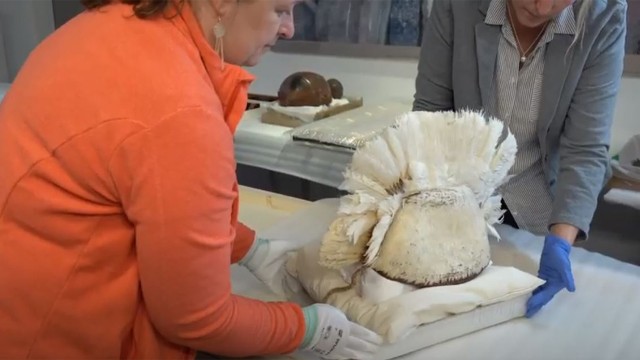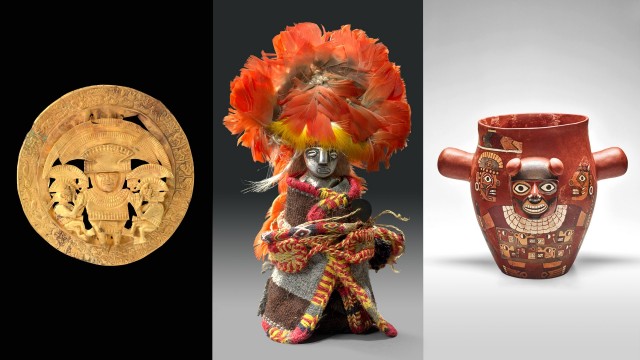Behind the Scene
May 6th, 2020
The profession of Collections Archivist

Behind the Scenes of a Major Exhibition at Pointe-à-Callière!
By Marie-Ève Bertrand, Collections Archivist at Pointe-à-Callière
This article is from Cité Magazine. Produced by the Pointe-à-Callière Foundation, the magazine is aimed at Museum Members, donors, partners, and sponsors. Become a Member of the Museum to read all of Cité Magazine’s exclusive content.
When visiting a temporary exhibition, have you ever wondered about the steps involved in bringing it all together to achieve the end result? Who are the people who work on an exhibition project, leading up to its opening day?
As a collections archivist, I will try to answer these questions by explaining my role in the production process. But first and foremost, I have to mention that putting together an exhibition is a major team effort! An exhibition project manager takes on the lead role, supervising and coordinating all of the others involved and overseeing the various steps over the course of a year. This person begins the assignment by searching for and choosing the objects to be borrowed for the exhibition. He or she will contact various institutions to assess loan options and their conditions. The borrower becomes responsible for the objects until the moment they are returned to the lenders when an exhibition is over.
The various actors working under the supervision of the project manager might include:
- a director, to do research and write the script and text for the exhibition and its accompanying catalogue
- a scientific committee, to validate the accuracy of information regarding the topics being addressed
- an exhibition designer, to create an exhibition layout for visitors to follow, based on the exhibition rooms—which includes furniture, display cases, and scenery—and to design the placement of the objects presented in display cases
- an audio-visual production team
- a team of furniture makers and handlers, to install the furniture and scenery in the rooms
- artifact handling specialists—called “white gloves”—, to manufacture custom mounts and install objects in the display cases
- freight carriers specializing in the transportation of works of art, to ship objects back and forth between the lenders and the Museum
- a team of document researchers, to make requests for iconography and the rights to use the images and videos that will be shown
- an exhibitions museology technician, to manage the furniture and the ordering of materials and tools used to assemble the exhibition
- a conservation technician, to ensure that conservation, temperature, and relative humidity standards are adequate in the exhibition rooms
- a security and building team, to ensure that all safety standards are respected before, during, and after the exhibition is set-up
Not to mention all of the labour involved in the exhibition assembly and disassembly, the communications team to handle promotion, the administration, our cultural activities team, and the guides who need to prepare to give you tours!
My role, as a collections archivist, begins the moment a list of objects has been created to request loans from various institutions or private lenders for inclusion in the exhibition. I join the project by creating a database of objects from various collections. Each object gets an individual data sheet that includes several pieces of information, for example: the lender’s name, an image of the object and its name, an acquisition number, its dimensions and materials, its dating and provenance, insurance value, presentation and conservation conditions, etc.
As the project moves ahead, new information is added, such as the exhibition zone number, display case number, type of display case, transport crate number, and type of packing used.
Beyond the production and design of the exhibition, coordinating the transportation of objects remains a very important step. Often, for international exhibitions, objects come from various institutions in different countries. If we take the It’s Circus Time! exhibition, scheduled for summer 2021, as an example, there will be over 300 objects coming from 24 different lenders, including three institutions in France, two in the United States, and others in various regions of Québec. You can imagine the logistical complexity and organization involved in packing and transporting such objects. It is also important to check the sizes and weights of the crates being used in order to make sure they fit in a plane’s cargo hold and in the Museum’s freight elevator.
For objects that contain animal or vegetable materials, there are permits called “CITES” (for the Convention on International Trade in Endangered Species of Wild Fauna and Flora) that are required to take the objects out of certain territories, and that must be taken into consideration well before arranging for transportation. If the documentation is not adequate, certain pieces will not be able to be included in the exhibition.
When the design plans are final, our museology technician and I make sure that the selected display cases are available and that the exhibition material in our inventory is reused as much as possible—in order to keep production costs down and to help reduce our environmental impact. Working meetings with the “white gloves” team are essential to determining a number of different aspects: the types of mounts that must be built for each of the objects according to their position in the display cases and their fragility, the need for exhibition pedestals, the list of materials to purchase for the exhibition assembly, and the number of people required to set it up in the exhibition rooms in order to meet the deadline.
Following these meetings, a detailed assembly schedule is created. Every single step must be included to make sure that it all goes off like clockwork! This schedule includes dates for the delivery of the empty crates for the current exhibition; the disassembly and packing of objects for the exhibition when it comes to an end; the departure of the crates containing the objects from the exhibition; the disassembly and assembly of the scenery in the exhibition rooms, including furniture and display cases; the departure and arrival of furniture at the loading dock; the arrival of the crates for the new exhibition; the unpacking and assessment of the condition of all of the objects; the installation of the objects by display case, by day, and by lender; the departure of empty crates headed for storage; lighting and audio-visual set-ups; the installation of panels and descriptive plates… And this goes on until the exhibition is inaugurated and opens to the public! Everything must be planned in advance in order to avoid traffic at the loading dock, in the freight elevator, and in the exhibition rooms.
As for the objects being displayed, a very limited number of people can touch them. When a conveyor is sent to accompany the objects, very often this is the person who handles them. A conveyor is an individual who represents a museum and is responsible for the objects on loan. Most of the time, this person is a curator or manager—the equivalent of a collections archivist. The person who signs condition reports must also be permitted to touch the objects and examine them up close.
I am sometimes asked what makes for a nice surprise in my line of work. There are many! For example, when we’ve already got crates for transporting objects (reduced transportation costs), when object mounts already exist (which saves time during the set-up), or when conveyors have already been to the Museum for previous exhibitions (a bond of trust has already been established), to name but a few.
And what about challenges? There are a few of those too! For example, what do we do when dimensions are too large, or when objects and crates are too heavy to go into our freight elevator and make it up to the exhibition rooms? We also have to pay special attention to the materials of certain objects that are sensitive to temperature and light, and make sure that CITES permit requests are completed for objects to exit and enter certain areas, notably when dealing with certain endangered species (e.g. ivory, feathers, etc.). Between the end of one exhibition and the opening of the next, we have from five to six weeks for the “set change.” It is during this key period that everything has to happen. There’s excitement in the air, adrenaline levels are at their max… it’s the moment when all of the preparations finally come together!
While the furniture and new scenery take shape, we receive crates filled with the new objects, along with their accompanying conveyors. On occasion, I have to make my way to the airport to be on hand when the crates arrive and to greet the conveyors. We are on-site for the “depalletization” of the crates and their handling as they are placed onto the truck that will take them to the Museum—always a very serious and solemn moment. Once the objects are unpacked (and we can finally see them with our own eyes!), we proceed with the signing of the condition reports and then categorize the objects by display case. The “white gloves” team then comes to take a look at the objects so they can create secure, custom-made mounts for their display. When the objects are placed in the display cases, we have to make sure that the order of presentation follows the numbers indicated on the descriptive plates and the direction of the exhibition layout. My main role during this stage involves coordinating all of the teams on-site to make sure that the assembly schedule is respected.
When the furniture in the exhibition rooms is ready, access to the rooms remains limited and a security perimeter is required. These are long days that involve meticulous work, where attention to detail is key so that the final result is perfect!
Sometimes, on exceptional occasions, the media is invited to come get a preview of the objects as they are unpacked.
There are so many steps—with interpersonal relationships all linked to one another—involved in taking an exhibition project to completion. It’s wonderful to play a role in bringing exhibitions to life—each one has its own challenges, each one is magical, and we all have our favourites! I feel privileged to be part of this big team and to be able to put my own personal stamp on our various projects.
Marie-Ève Bertrand
Collections Archivist
Pointe-à-Callière










